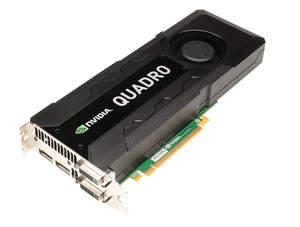Nvidia Maximus Arrives With Kepler Foundation
Nvidia unveiled Maximus 2.0, the company's second generation workstation graphics platform consisting of Quadro graphics and Tesla acceleration.
Maximus 2.0 is based on GK110 Kepler architecture, and offers the Quadro K5000 as well as the Tesla K20 GPU. According to Nvidia, the new workstation card enables developers to reference over 1 million textures directly in memory, take advantage of FXAA/TXAA film-style anti-aliasing technologies and use up to four displays simultaneously. The integrated Display Port 1.2 supports resolutions up to 3840x2160 pixels at 60 Hz. The frame buffer has been increased to 4 GB and PCIe 3 has been added.
Kepler also benefits the new Tesla products and provides a three-fold increase inc omputational efficiency, Nvidia said, while dynamic parallelization simplify the development of multi-threaded apps and provide greater performance overall.
Workstations integrating the Quadro K5000 and Tesla K20 will become available in December. The standalone K5000 will enter retail in October and is priced at $2,249 MSRP. The K20 will be available for $3,199 MSRP.
Contact Us for News Tips, Corrections and Feedback
Get Tom's Hardware's best news and in-depth reviews, straight to your inbox.

Wolfgang Gruener is an experienced professional in digital strategy and content, specializing in web strategy, content architecture, user experience, and applying AI in content operations within the insurtech industry. His previous roles include Director, Digital Strategy and Content Experience at American Eagle, Managing Editor at TG Daily, and contributing to publications like Tom's Guide and Tom's Hardware.
-
CaedenV uglynerdmanthats nice but can it run crysis? /sarcasm off.this is what you use to MAKE crysis!Reply -
CaedenV spookieIs it really worth that price tag?? How much could it really cost to build it?These are cards for professionals. In the consumer market it is a question of how much it costs to make, assemble, market, and support, while still allowing a profit margin for the manufacturer of the chip, the manufacturer of the card, and the reseller (typically 5-20% markup for each step). It is all about having the cheapest product that gets the job done with an 'acceptable' failure rate. That is now how 'pro' equipment is priced.Reply
Professionals dont care (much) about the up front cost of a tool or product. What they care about is the efficiency of the workflow. Think of a video editor (though not the best example for this specific card, just a workflow I am familiar with, but the same general argument can be made for others). A small-time wedding videographer needs to pump our 2-6 videos a month to keep up with demand. Lets say that editing takes ~20-40 hours (importing, AV cleanup, editing, 'effects' and titles, and exporting). That leaves relatively little time allotted for lining up new gigs, actuially shooting projects, or looking at ways to expand or run the business. Also, most of the business lines up in a 2-3 month window during the spring, and how fast you can pump out a quality product determines how much money you will make that year. So getting a card (no matter the expense) that can help speed up that 20-40 hour workflow and shrink it down to ~15-30 hours means that you can all the sudden take on 1/3rd more projects, charge a little more because of your popularity and ability to get the customer their video in a timely manner (something most videographers suck at), or spend that extra time to hire/train new help, or administer the business end of things. Just on that alone it is worth every penny.
Conversely; What happens when your rig goes down? Missed deadlines typically means giving a discount to your customer, but more importantly it means that word-of-mouth advertising and referrals (which business relies upon) will not happen, and in fact you will likely loose business. That down time costs thousands, if not tens of thousands of dollars, hurts your reputation, and delays or looses further business. These pro cards are much beefier, and meant to run 24/7, where as game cards are more designed to run 4/6, so if you are a professional what would you trust? -
sslapikas spookieIs it really worth that price tag?? How much could it really cost to build it?Reply
Nothing in this world is worth price tag. It is worth what people are willing to pay for it. -
CaedenV Hey Toms, Could you do more benches on these types of 'pro' products? I realize they are much harder to bench and compare, but there are very few reviewers who review these types of products, and even fewer who do a good job at it. I would love to see how these stack up against AMD FirePro cards, as well as how they stack up against high end gamer cards for those who are transitioning to professional workloads and are not sure what level of product to purchase.Reply -
kronos_cornelius uglynerdmanthats nice but can it run crysis? /sarcasm off.The updated question is Can Crysis run at 3840x2160 resolution ?Reply
